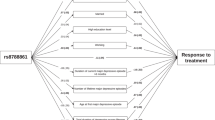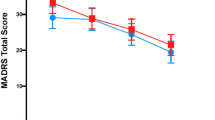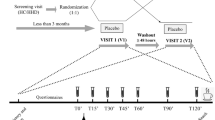Abstract
There is compelling evidence for the involvement of hypothalamic-pituitary-adrenal (HPA) axis abnormalities in depression. Growing evidence has suggested that the combined dexamethasone (DEX)/corticotropin-releasing hormone (CRH) test is highly sensitive to detect HPA axis abnormalities. We organized a multicenter study to assess the DEX/CRH test as a state-dependent marker for major depressive episode in the Japanese population. We conducted the DEX/CRH test in 61 inpatients with major depressive episode (Diagnostic and Statistical Manual of Mental Disorders 4th edition (DSM-IV)) and 57 healthy subjects. In all, 35 patients were repeatedly assessed with the DEX/CRH test on admission and before discharge. The possible relationships between clinical variables and the DEX/CRH test were also examined. Significantly enhanced pituitary–adrenocortical responses to the DEX/CRH test were observed in patients on admission compared with controls. Such abnormalities in patients were significantly reduced after treatment, particularly in those who underwent electroconvulsive therapy (ECT) in addition to pharmacotherapy. Age and female gender were associated with enhanced hormonal responses to the DEX/CRH test. Severity of depression correlated with DEX/CRH test results, although this was explained, at least in part, by a positive correlation between age and severity in our patients. Medication per se was unrelated to DEX/CRH test results. These results suggest that the DEX/CRH test is a sensitive state-dependent marker to monitor HPA axis abnormalities in major depressive episode during treatment. Restoration from HPA axis abnormalities occurred with clinical responses to treatment, particularly in depressed patients who underwent ECT.
Similar content being viewed by others
Log in or create a free account to read this content
Gain free access to this article, as well as selected content from this journal and more on nature.com
or
References
Albala AA, Greden JF, Tarika J, Carroll BJ (1981). Changes in serial dexamethasone suppression tests among unipolar depressive receiving electroconvulsive treatment. Biol Psychiatry 16: 551–560.
American Psychiatric Association (1987). The dexamethasone suppression test: an overview of its current status in psychiatry: the APA task force on laboratory tests in psychiatry. Am J Psychiatry 144: 1253–1262.
American Psychiatric Association (1994). Diagnostic and Statistical Manual of Mental Disorders, 4th edn. American Psychiatric Association: Washington, DC.
Aperia B, Thoren M, Zettergren M, Wetterberg L (1984). Plasma pattern of adrenocorticotropin and cortisol during electroconvulsive therapy in patients with major depressive illness. Acta Psychiatr Scand 70: 361–369.
Baghai TC, Schule C, Zwanzger P, Minov C, Holme C, Padberg F et al (2002). Evaluation of a salivary based combined dexamethasone/CRH test in patients with major depression. Psychoneuroendocrinology 27: 385–399.
Carroll BJ (1982). The dexamethasone suppression test for melancholia. Br J Psychiatry 140: 292–304.
Carroll BJ, Feinberg M, Greden JF, Tarika J, Albala AA, Haskett RF et al (1981). A specific laboratory test for the diagnosis of melancholia: standardization, validation, and clinical utility. Arch Gen Psychiatry 38: 15–22.
Coryell W (1986). Are serial dexamethasone suppression tests useful in electroconvulsive therapy? J Affect Disord 10: 59–66.
Deuschle M, Schmider J, Weber B, Standhardt H, Korner A, Lammers CH et al (1997). Pulse-dosing and conventional application of doxepin: effects on psychopathology and hypothalamus-pituitary-adrenal (HPA) system. J Clin Psychopharmacol 17: 156–160.
Deuschle M, Schweiger U, Gotthardt U, Weber B, Korner A, Schmider J et al (1998). The combined dexamethasone/corticotropin-releasing hormone stimulation test is more closely associated with features of diurnal activity of the hypothalamo-pituitary-adrenocortical system than the dexamethasone suppression test. Biol Psychiatry 43: 762–766.
Devanand DP, Decina P, Sackeim HA, Hopkins N, Novacenko H, Malitz S (1987). Serial dexamethasone suppression tests in initial suppressors and nonsuppressors treated with electroconvulsive therapy. Biol Psychiatry 22: 463–472.
Devanand DP, Sackeim HA, Lo ES, Cooper T, Huttinot G, Prudic J et al (1991). Serial dexamethasone suppression tests and plasma dexamethasone levels: effects of clinical response to electroconvulsive therapy in major depression. Arch Gen Psychiatry 48: 525–533.
Fink M, Gujavarty K, Greenberg L (1987). Serial dexamethasone suppression tests and clinical outcome in ECT. Convuls Ther 3: 111–120.
Frieboes RM, Sonntag A, Yassouridis A, Eap CB, Baumann P, Steiger A (2003). Clinical outcome after trimipramine in patients with delusional depression—a pilot study. Pharmacopsychiatry 36: 12–17.
Gervasoni N, Bertschy G, Osiek C, Perret G, Denis R, Golaz J et al (2004). Cortisol responses to combined dexamethasone/CRH test in outpatients with a major depressive episode. J Psychiatr Res 38: 553–557.
Greden JF, Gardner R, King D, Grunhaus L, Carroll BJ, Kronfol Z (1983). Dexamethasone suppression tests in antidepressant treatment of melancholia: the process of normalization and test–retest reproducibility. Arch Gen Psychiatry 40: 493–500.
Grunhaus L, Zelnik T, Albala AA, Rabin D, Haskett RF, Zis AP et al (1987). Serial dexamethasone suppression tests in depressed patients treated only with electroconvulsive therapy. J Affect Disord 13: 233–240.
Hamilton M (1967). Development of a rating scale for primary depressive illness. Br J Soc Clin Psychol 6: 278–296.
Hatzinger M, Hemmeter UM, Baumann K, Brand S, Holsboer-Trachsler E (2002). The combined DEX–CRH test in treatment course and long-term outcome of major depression. J Psychiatr Res 36: 287–297.
Hatzinger M, Reul JM, Landgraf R, Holsboer F, Neumann I (1996). Combined dexamethasone/CRH test in rats: hypothalamo-pituitary-adrenocortical system alterations in aging. Neuroendocrinology 64: 349–356.
Hatzinger M, Wotjak CT, Naruo T, Simchen R, Keck ME, Landgraf R et al (2000). Endogenous vasopressin contributes to hypothalamic-pituitary-adrenocortical alterations in aged rats. J Endocrinol 164: 197–205.
Heuser I, Yassouridis A, Holsboer F (1994b). The combined dexamethasone/CRH test: a refined laboratory test for psychiatric disorders. J Psychiatr Res 28: 341–356.
Heuser IJ, Gotthardt U, Schweiger U, Schmider J, Lammers CH, Dettling M et al (1994a). Age-associated changes of pituitary-adrenocortical hormone regulation in humans: importance of gender. Neurobiol Aging 15: 227–231.
Heuser IJ, Schweiger U, Gotthardt U, Schmider J, Lammers CH, Dettling M et al (1996). Pituitary-adrenal-system regulation and psychopathology during amitriptyline treatment in elderly depressed patients and normal comparison subjects. Am J Psychiatry 153: 93–99.
Holsboer F (1995). Neuroendocrinology of mood disorders. In: Bloom FE, Kupfer DJ (eds). Psychopharmacology: The Fourth Generation of Progress. Raven Press: New York. pp 957–969.
Holsboer F, Lauer CJ, Schreiber W, Krieg JC (1995). Altered hypothalamic-pituitary-adrenocortical regulation in healthy subjects at high familial risk for affective disorders. Neuroendocrinology 62: 340–347.
Holsboer F, Liebl R, Hofschuster E (1982). Repeated dexamethasone suppression test during depressive illness: normalisation of test result compared with clinical improvement. J Affect Disord 4: 93–101.
Holsboer F, von Bardeleben U, Wiedemann K, Muller OA, Stalla GK (1987). Serial assessment of corticotropin-releasing hormone response after dexamethasone in depression. Implications for pathophysiology of DST nonsuppression. Biol Psychiatry 22: 228–234.
Holsboer-Trachsler E, Stohler R, Hatzinger M (1991). Repeated administration of the combined dexamethasone-human corticotropin releasing hormone stimulation test during treatment of depression. Psychiatry Res 38: 163–171.
Ising M, Lauer CJ, Holsboer F, Modell S (2005). The Munich vulnerability study on affective disorders: premorbid neuroendocrine profile of affected high-risk probands. J Psychiatr Res 39: 21–28.
Kudielka BM, Schmidt-Reinwald AK, Hellhammer DH, Kirschbaum C (1999). Psychological and endocrine responses to psychosocial stress and dexamethasone/corticotropin-releasing hormone in healthy postmenopausal women and young controls: the impact of age and a two-week estradiol treatment. Neuroendocrinology 70: 422–430.
Kunugi H, Urushibara T, Nanko S (2004). Combined DEX/CRH test among Japanese patients with major depression. J Psychiatr Res 38: 123–128.
Kunzel HE, Binder EB, Nickel T, Ising M, Fuchs B, Majer M et al (2003). Pharmacological and nonpharmacological factors influencing hypothalamic-pituitary-adrenocortical axis reactivity in acutely depressed psychiatric in-patients, measured by the Dex–CRH test. Neuropsychopharmacology 28: 2169–2178.
Oshima A, Yamashita S, Owashi T, Murata T, Tadokoro C, Miyaoka H et al (2000). The differential ACTH responses to combined dexamethasone/CRH administration in major depressive and dysthymic disorders. J Psychiatr Res 34: 325–328.
Papakostas Y, Fink M, Lee J, Irwin P, Johnson L (1981). Neuroendocrine measures in psychiatric patients: course and outcome with ECT. Psychiatry Res 4: 55–64.
Plotsky PM, Owens MJ, Nemeroff CB (1998). Psychoneuroendocrinology of depression: hypothalamic-pituitary-adrenal axis. Psychiatr Clin N Am 21: 293–307.
Revskoy S, Redei E (2000). Decreased in vitro sensitivity to dexamethasone in corticotropes from middle-age rats. Exp Gerontol 35: 237–242.
Rybakowski JK, Twardowska K (1999). The dexamethasone/corticotropin-releasing hormone test in depression in bipolar and unipolar affective illness. J Psychiatr Res 33: 363–370.
Schmider J, Lammers CH, Gotthardt U, Dettling M, Holsboer F, Heuser IJ (1995). Combined dexamethasone/corticotropin-releasing hormone test in acute and remitted manic patients, in acute depression, and in normal controls: I. Biol Psychiatry 38: 797–802.
Schule C, Baghai T, Zwanzger P, Ella R, Eser D, Padberg F et al (2003). Attenuation of hypothalamic-pituitary-adrenocortical hyperactivity in depressed patients by mirtazapine. Psychopharmacology (Berlin) 166: 271–275.
Schule C, Baghai T, Zwanzger P, Minov C, Padberg F, Rupprecht R (2002). Sleep deprivation and hypothalamic-pituitary-adrenal (HPA) axis activity in depressed patients. J Psychiatr Res 35: 239–247.
Swartz CM, Chen JJ (1985). Electroconvulsive therapy-induced cortisol release: changes with depressive state. Convuls Ther 1: 15–21.
von Bardeleben U, Holsboer F (1989). Cortisol response to a combined dexamethasone–human corticotrophin-releasing hormone challenge in patients with depression. J Neuroendocrinol 1: 485–488.
von Bardeleben U, Holsboer F (1991). Effect of age on the cortisol response to human corticotropin-releasing hormone in depressed patients pretreated with dexamethasone. Biol Psychiatry 29: 1042–1050.
Watson S, Gallagher P, Del-Estal D, Hearn A, Ferrier IN, Young AH (2002). Hypothalamic-pituitary-adrenal axis function in patients with chronic depression. Psychol Med 32: 1021–1028.
Watson S, Gallagher P, Ritchie JC, Ferrier IN, Young AH (2004). Hypothalamic-pituitary-adrenal axis function in patients with bipolar disorder. Br J Psychiatry 184: 496–502.
Zobel AW, Nickel T, Sonntag A, Uhr M, Holsboer F, Ising M (2001). Cortisol response in the combined dexamethasone/CRH test as predictor of relapse in patients with remitted depression: a prospective study. J Psychiatr Res 35: 83–94.
Zobel AW, Schulze-Rauschenbach S, von Widdern OC, Metten M, Freymann N, Grasmader K et al (2004). Improvement of working but not declarative memory is correlated with HPA normalization during antidepressant treatment. J Psychiatr Res 38: 377–383.
Zwanzger P, Baghai TC, Padberg F, Ella R, Minov C, Mikhaiel P et al (2003). The combined dexamethasone–CRH test before and after repetitive transcranial magnetic stimulation (rTMS) in major depression. Psychoneuroendocrinology 28: 376–385.
Acknowledgements
We thank Ms Kazuko Sakai for her substantial assistance. This study was supported in part by a grant from the Mitsubishi Pharma Corporation and by a research grant from the Ministry of Health, Labor, and Welfare of Japan.
Author information
Authors and Affiliations
Corresponding author
Rights and permissions
About this article
Cite this article
Kunugi, H., Ida, I., Owashi, T. et al. Assessment of the Dexamethasone/CRH Test as a State-Dependent Marker for Hypothalamic-Pituitary-Adrenal (HPA) Axis Abnormalities in Major Depressive Episode: A Multicenter Study. Neuropsychopharmacol 31, 212–220 (2006). https://doi.org/10.1038/sj.npp.1300868
Received:
Revised:
Accepted:
Published:
Issue date:
DOI: https://doi.org/10.1038/sj.npp.1300868
Keywords
This article is cited by
-
Glucocorticoid Receptor Down-Regulation Affects Neural Stem Cell Proliferation and Hippocampal Neurogenesis
Molecular Neurobiology (2024)
-
Bidirectional relationship between heroin addiction and depression: Behavioural and neural studies
Current Psychology (2022)
-
Gradient of electro-convulsive therapy’s antidepressant effects along the longitudinal hippocampal axis
Translational Psychiatry (2021)
-
Ex vivo glucocorticoid receptor-mediated IL-10 response predicts the course of depression severity
Journal of Neural Transmission (2021)
-
Depressive Symptoms Mediate the Relationship between Emotional Cutoff and Type 2 Diabetes Mellitus
International Journal of Behavioral Medicine (2019)



